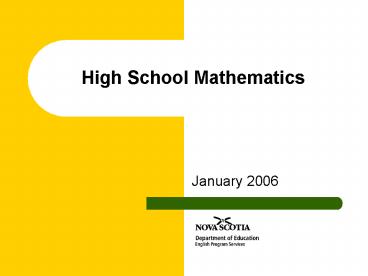High School Mathematics PowerPoint PPT Presentation
1 / 21
Title: High School Mathematics
1
High School Mathematics
- January 2006
2
The First Step to SuccessinHigh School
Mathematics
- Selecting the Most Appropriate Courses
3
Why do we have a variety of courses?
- So all students can be successful
- To address the differences in the students
abilities in mathematics - To address the differences in the students
interests in mathematics - To address the differences in the students
future plans
4
How many students should we anticipate will take
courses at the different levels?
- It is anticipated that approximately 3040 of
grade 10 students will enrol in graduation-level
courses and approximately 6070 of grade 10
students will enrol in the academic mathematics
course.
5
What changes between grade 9 and grade 10
mathematics?
- In grade 9, the needs of all students have to be
met in one course in grade 10, the needs of
students are met in three courses - In grade 9, students have mathematics every day
for the whole school year, ideally 1 hour per
day in grade 10, all courses, except the plus
courses, have 110 hours in one semester - In grade 9, students are promoted by grade in
grade 10, students are promoted by courses - In grade 9, students are offered a full slate of
adaptations in grade 10, the first consideration
is placement in the appropriate course, and a
limited menu of adaptations is available in the
Math 10 course
6
What are the implications of these changes
between grades?
- The students need to take the grade 10 course
that best matches a combination of their previous
achievements, their mathematical abilities, their
interests and motivations, and the requirements
for their post-secondary aspirations - Students need to be aware that the general
expectations for the average student in grade 9
are similar to the expectations for students in
Math Foundations 10, and the general expectations
for the above average student in grade 9 are
similar to the expectations for students in Math
10
7
A Typical Grade 9 Class of 30 Students
1. . . . 10. . . . 15. Middle to Average Student.
The Grade 9 Teacher focuses their lessons to this
student, differentiating for students who work
above or below this point. . . . 20. . . . 30.
8
These 30 Students in Grade 10
1. . . . 10. . . . 15. . . 20. . . . 30.
If we assume ? of the students who have their
needs better met by a graduation level course.
9
Mathematics 10
1. . . . 10. . . . 15. then the Middle to
Average Student from Grade 9 is now in the
bottom ¼ of the Mathematics 10
class . . . 20.
10
Mathematics 10
1. . . . 10. The teacher is now teaching to a
new middle to average student which is a
step up from where the Grade 9 teacher was
focused. . . . 15. . . . 20.
11
What are the course options and prerequisites?
- See yellow handout
- Mathematics Essentials 10
- (graduation, 1 credit)
- Prerequisite Successful completion of
Mathematics Grade 8 and recommendation from the
Mathematics Grade 9 teacher - Mathematics Foundations 10
- (graduation, 1 credit)
- Prerequisite Successful completion Mathematics
Grade 9 - Mathematics 10
- (academic, 1 credit)
- Prerequisite Successful completion of
Mathematics Grade 9 and demonstrated good to
excellent performance in relation to the expected
learning outcomes prescribed for Mathematics
Grade 9 - Mathematics 10 Plus
- (academic, 2 credits)
- Prerequisite Successful completion of
Mathematics Grade 9 and recommendation from the
Mathematics Grade 9 teacher
12
When a student is entering grade 10, what should
he or she consider when registering for math
courses?
- Considerations
- previous mathematics achievement (prerequisites)
- interest
- attitude
- ability to work independently
- work habits
- future plans
- the appropriate level of challenge of the course
13
High School Mathematics Pathways
- For a flowchart of high school Mathematics
pathways see blue handout.
14
Course Selection
- Post-Secondary Implications
15
Post-Secondary Implications
- Post-secondary programs have different
mathematics prerequisites and should be carefully
investigated during the course selection process.
- It is important to note that many post-secondary
programs do not have a mathematics prerequisite
and that graduation-level mathematics credits
will satisfy admissions requirements. - Selecting courses on the premise of keeping all
doors opened without considering the above, is
not in the best interest of students. Doing well
in the appropriate course gives students more
options than struggling through an ill chosen
course.
16
Post-Secondary Implications
- Mathematics 10
- Mathematics 10 is designed for those who plan to
enter into fields requiring further
post-secondary study of Calculus. - Examples include, but are not limited to, the
sciences, engineering, and business
administration at university, college, or private
institutions.
17
Post-Secondary Implications
- Mathematics Foundations 10
- Mathematics Foundations 10 is designed for
students who want to maintain a high standard of
mathematics but who do not intend to enter
post-secondary programs that require academic
mathematics as a prerequisite. - Examples include, but are not limited to, the
arts and fine arts at university as well as 102
out of the 120 programs at NSCC.
18
Post-Secondary Implications
- Mathematics Essentials 10
- Mathematics Essentials 10 is designed for
students who do not intend to pursue
post-secondary study, or who plan to enter
programs that do not have any mathematics
prerequisite. - Examples include, but are not limited to, the
arts and fine arts at university as well as 102
out of the 120 programs at NSCC.
19
Post-Secondary Implications
- Additional Resources
- See the Mathematics Career Pathways poster.
- See pink handout
20
Summary
- See purple handout for a summary of options for
your child.
21
Frequently Asked QuestionsHigh School
Mathematics
- Donna Karsten
- Mathematics Consultant
- 902-424-5437
- karstend_at_gov.ns.ca

